The effective long-tail keyword strategy in 2025 (full course)
To rank higher in search engines, website owners and businesses adopt different keyword strategies. But long-tail keyword strategy can be very effective since it targets specific search queries.
Long-tail keyword strategy is a method of producing high-value organic website traffic by focusing on long-tail keywords, which are search queries that contain three or more words.
This technique has a lower search volume and competitiveness rate than short-tail keywords, as well as a greater conversion rate. So grab a cup of coffee and focus on how you can implement the best long-tail keyword tips in your content to get found on SERPs.
Why should you use a long-tail keyword strategy?

Long tail keywords strategy is made up of a few words, which makes them considerably more targeted and unique. This implies that both visitors and site owners will get better search results.
Brands will receive traffic that is more directly related to their content, improving their ability to successfully attract new customers into the sales cycle.
Long-tail keyword strategy VS short-keyword strategy
Long-tail keyword strategy and a short-keyword strategy are drastically different. Each strategy has its own keyword length, target, and search volume. We recap their main differences in the table below:
| Aspect | Short Keyword Strategy | Long Keyword Strategy |
| Keyword Length | Typically 1-2 words | Typically 3 or more words |
| Search Volume | High search volume, more competition | Lower search volume, less competition |
| Specificity | Less specific, broader audience | Highly specific, niche audience |
| SEO Difficulty | Often more competitive and harder to rank | Easier to rank due to lower competition |
| User Intent | May have a variety of user intents | Typically reflects precise user intent |
| Conversion Rates | May have lower conversion rates | Often has higher conversion rates |
| Content Relevance | Requires more in-depth content to match user intent | Easier to align content with user needs |
| Target Audience | Appeals to a wider and more diverse audience | Targets a more focused and engaged audience |
| Examples | “Laptops,” “Fitness tips” | “Best laptops for video editing,” “Effective cardio workouts for weight loss” |
Long-tail Keyword Strategy Search
Long-tail keyword strategy necessitates the use of tools that assist content marketers and bloggers in locating low-competitive keywords that will rank high in SERPs. We recommend the following tools:
1. Answer the public: long-tail keyword finder

Answer The Public is a great tool for long-tail keyword recommendations since it creates frequently asked questions about your seed term (the phrase you entered initially) on social media, blogs, and forums.
It also provides comparative keywords, which might provide high chances of ranking in related searches. Check out the “versus” area of AnswerThePublic for your phrase and you’ll be shocked at how many people search for X vs Y (for example, Instagram vs Snapchat).
Even though the keyword ideas are extensive, one disadvantage of AnswerThePublic is that it does not disclose search volume data. Without this information, which is essential for making educated judgments, the Pro version isn’t quite as valuable as some of the other long-tail keyword tools on our list. However, it remains a valuable resource for marketers.
2. Semrush
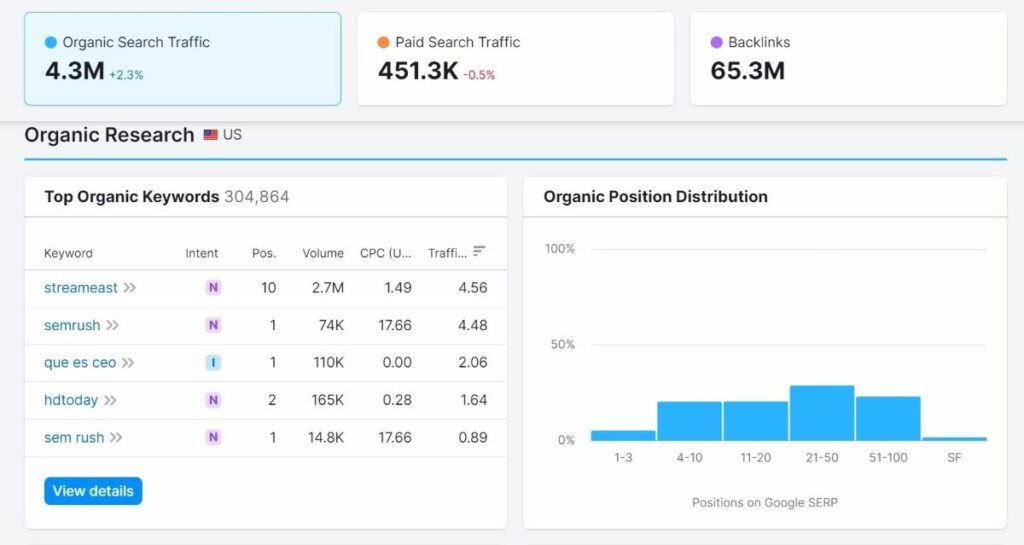
Semrush is the market’s most powerful search marketing platform. It has strong keyword research tools that make it simple to locate long-tail keywords.
Long-tail keywords can be sorted by search volume, keyword difficulty, cost per click, and other metrics.
Semrush makes it simple to track SERPs and your website’s performance for various keywords. You may also do an SEO competitor study to see which keywords are producing the most traffic for your competitors.
Semrush also offers a free plan that is useful for locating long-tail keywords. However, the commercial plans provide access to extremely powerful features that are well worth the premium price.
3.KWfinder
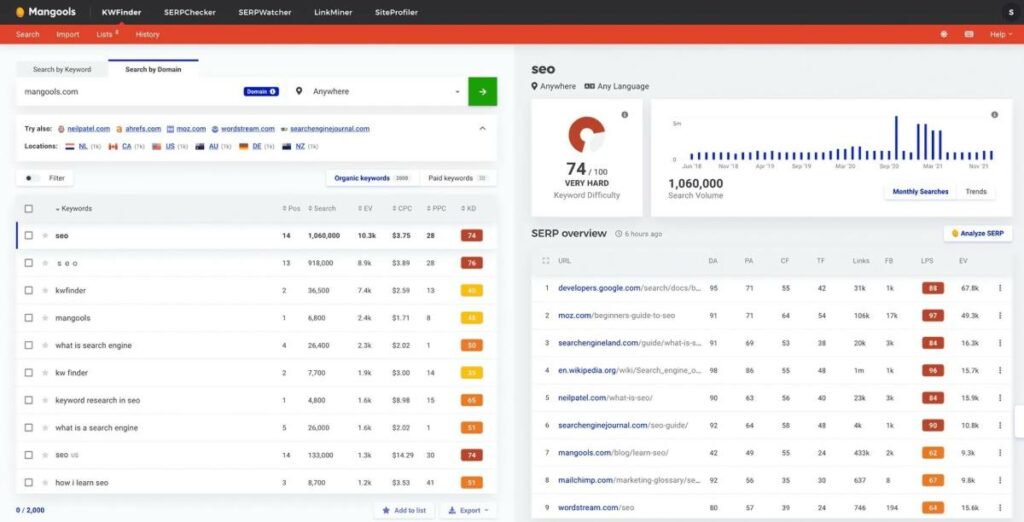
KWFinder emerges as a standout tool designed specifically for generating long-tail keyword ideas, distinguishing itself by dedicating its focus primarily to in-depth keyword research. This specialization sets KWFinder apart from broader SEO platforms like Semrush and Ahrefs, providing users with a more targeted approach to uncovering valuable, less competitive keywords critical for SEO strategies.
It excels in delivering comprehensive keyword data, offering insights into search traffic, historical trends, the level of keyword difficulty, and visitor metrics, enabling users to make informed decisions when selecting keywords to target.
Unlike its competitors, KWFinder allows for highly specific searches, facilitating the exploration of keywords within distinct geographic regions and languages. This feature is particularly beneficial for localized SEO efforts or global campaigns aiming to tap into new markets.
Additionally, KWFinder offers functionality to track keyword performance, giving users the ability to monitor their rankings within the SERPs (Search Engine Results Pages) over time.
This feature is invaluable for assessing the effectiveness of chosen keywords and refining SEO strategies based on real-world performance.
4. Google Trends
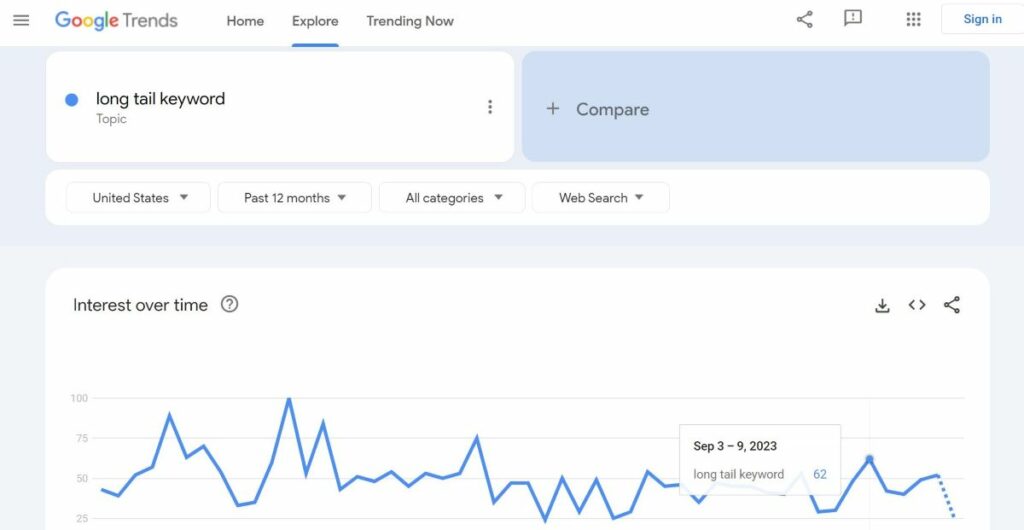
Google Trends gives global insights into Google search statistics. You may look for certain nations to discover how certain subjects are trending in those countries.
Here are the data points provided by Google Trends:
What about interest over time? To determine how much interest your issue has, you may choose your period to be as recent as the last hour or as far back as 2004.
Subregional interest? When you filter by nation, you may see how your topic is trending in various regions of that country (such as states or provinces).
What are some related topics? You can find comparable trending themes to aid in the identification of content possibilities with high search potential.
Do you have any further questions? This will provide extra long-tail terms that have lately grown in the search results.
Google Trends also lets you compare up to five keywords to discover which ones have the most potential for search traffic.
5. LongTailPro

Long Tail Pro provides consumers with long-tail keyword ideas as well as local search traffic to assist them in identifying the finest keyword prospects for their content marketing initiatives.
Long Tail Pro can give up to 400 long-tail phrases once you submit a single head keyword. You may then aggregate or arrange your keywords using various criteria such as search volume, average CPC bid, rank value, and so on.
It also offers competitive statistics and a grade to assist you in determining which keywords are ideal for your brand to target.
6. Use AI
Incorporating Artificial Intelligence (AI) to unearth long-tail keywords is a forward-thinking strategy that significantly enhances the precision and effectiveness of search engine optimization (SEO). With its advanced algorithms and machine learning capabilities, AI can delve into extensive data pools across the internet to detect nuanced search patterns and user behaviors that are not immediately apparent.
This technology is adept at sifting through online conversations, search query databases, and content trends to spot underutilized, highly specific long-tail keywords that can attract a more targeted audience. By harnessing AI for this purpose, businesses and content creators can achieve a competitive edge, optimizing their online content in a way that aligns more closely with the actual search intent of their ideal customers.
This approach not only improves visibility in search engine results pages but also drives higher engagement rates by connecting with users through more relevant and contextually appropriate content.
Analyzing Search Intent
The question that we have to ask:
How to Identify Search Intent?
So, Understanding a user’s search query is critical. But how to do that?
Consider answering these questions and find the right answers:
What is the user looking for?
Then customize your content or blog post to their demands to boost the chances of your website appearing high in search engine results pages (SERPs).
Here are some long-tail keyword strategies for determining search intent:
1. Check the keywords
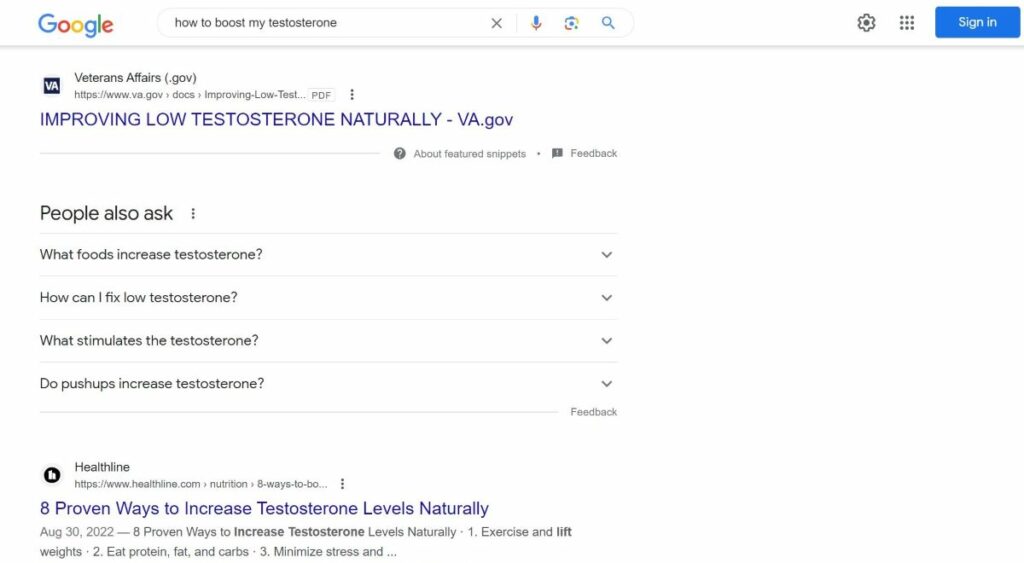
The first step in identifying search intent is to examine the terms entered into search engines. Do they require a certain product or service? Are they attempting to learn anything? Are they looking for an answer to a problem? You may get a feel of what they’re looking for by analyzing the keywords and phrases they’re using to search. In the above picture, we have typed a specific question: “How to boost my Testosterone”. Then we have found more search queries that people also ask; like “What food increases Testosterone?”, “How can I fix low Testosterone?”.
2. Go over the SERP results

Once you’ve determined what keywords people are using, examine the search engine results page (SERP) for those terms. What kind of material is at the top of the page?
Are there any product listings, blog entries, videos, or anything else?
Analyzing the SERP results will provide you with a fair indication of what sort of content is presently doing well for those keywords.
3. Analyse the user intent

Consider where the user is in their journey when they enter a certain search query. Are they only starting to look into a topic, or are they ready to buy? Recognizing the user’s aim at various points of their trip will assist you in tailoring your content to match their demands.
4. Check the search volume.
Search volume may also be used to predict user intent. For example, a high search volume for a term indicates that many people are seeking that exact thing.
Conversely, if a term has a low search volume, it may not be worth investing a significant amount of time and money in producing content around it.
5. Analyse Google’s searches
Google’s similar searches are a feature that may be an excellent tool for determining user intent. When you input a search query into Google, similar searches are frequently displayed at the bottom of the page.
These linked searches can provide you with suggestions for other keywords and phrases to target, as well as a sense of what other subjects and queries customers are interested in.
6. Improve your content.

Create high-quality, relevant material that corresponds to the user’s search intent, including the usage of the appropriate type of content (such as blog posts, product pages, or videos) to address the user’s requirements.
7. Complete technical SEO

Optimize your website to improve the user experience by focusing on technical elements such as page load speed and mobile responsiveness for online search experience.
Now that you know how to establish search intent, you can develop content that better fulfills the demands of your target audience and improves their user experience, resulting in increased traffic to your website and higher search engine rankings.
Long-tail keyword strategy for content creation.
To create high-quality content related to long-tail keyword strategies consider these tips:
Incorporating long-tail keywords into the article naturally
Incorporating long-tail keywords naturally into the material entails effortlessly including these unique, lengthier phrases or queries into your writing so that they look coherent and relevant to the reader. Rather than aggressively injecting keywords, it is critical to strive to generate meaningful content that answers the user’s requirements.
By including long-tail keywords naturally, you improve the user experience and boost the likelihood of your content appearing better in search engine results. Remember that readability and engagement should always come first.
Keyword stuffing should be avoided.
Keyword stuffing is the practice of employing a specific term or phrase to manipulate search engine results. It entails stuffing keywords into articles without regard for its natural flow and readability.
Search engines, on the other hand, have gotten sharper in recognizing and punishing such practices. Avoiding keyword stuffing guarantees that your content is user-friendly and valuable to your viewers.
Instead of forcing keywords into your content, focus on crafting high-quality, interesting material that combines important keywords naturally using semantic SEO tips.
You boost user experience and your chances of ranking high in search engine results by finding a balance between keyword usage and readability.
Using long-tail keyword variants
Using long-tail keyword variants refers to the practice of incorporating many forms or permutations of the core search phrase inside your content. This improves your chances of ranking better in search engine results by optimizing your content for a larger range of search queries.
Long-tail Keyword strategy for On-Page SEO
Use your core long-tail term to optimize title tags, meta descriptions, headers, and the URL. Use variants and synonyms of the term throughout the article as well.
Make sure the material not only answers the question but also adds value to the user. Link to other relevant pages on your website using long-tail keyword strategies that are comparable or related to generating topical authority and a better user experience.
Using H1, H2, and H3 Tags to Improve Your SEO Strategy.
When it comes to SEO strategy, well-crafted content is more significant than anything else. Make your message useful and relevant to your audience. If your piece promises to educate the reader something, keep writing valuable content using the best blogging tips.
Keep in mind that your H1, H2, and H3 tags help in communication. The more effectively your material targets their primary points of interest, the more likely they are to continue reading. Excessive keyword usage or unnecessary jargon should never take precedence over quality.
Image enhancement for long-tail keyword strategy
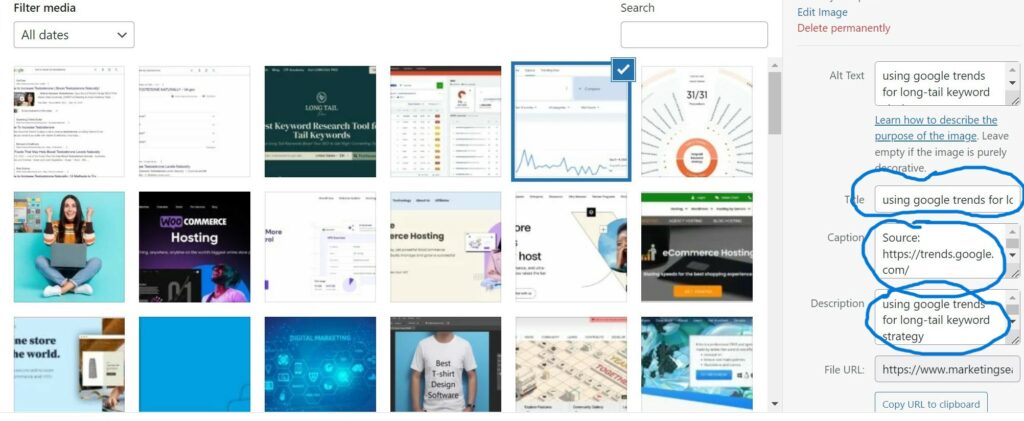
When your image is finished, you can’t just dump anything into your article to fill in the blanks. Optimize it by adding relevant captions to the image using long-tail keywords, making it accessible to people and Google bots.
Long tail keywords in picture SEO optimization may be effectively achieved by including the three elements of the image in any online content you write.
1. Captions
The text that appears beside the image on the page is known as the image caption. Let’s Consider this article. Examine the photographs. The captions are the text that appears beneath each image.
These captions are vital for picture SEO since people use them to find online content. There are four primary aspects that individuals examine while browsing online pages. They have Headings, Images, and captions.
So, do you have to provide captions to every pic now?
Not necessarily, because not all images serve the same purpose; some images, like those in a book, are just anesthetic’s front cover. So, you should constantly prioritize your users.
2. Alternate text
Even if the image can represent itself, alt text (or alt tag) is appended to it. It will be presented to the user for unknown reasons.
So, include the long tail keywords for that page in the alt text of any photos you employ.
However, like with the description, please keep in mind that not every image requires alt text.
Voice search and long-tail keyword approach.
Long-tail keyword strategy entails improving your content for Voice search.
How to do that?
Consider these tips:
Answer search intents briefly

Brevity is essential in the domain of voice search. Voice assistants excel in responding to user inquiries in a concise and to-the-point manner. It is critical to use a clear and informative strategy when optimizing your content for voice search.
Consider this scenario: a user asks a voice assistant, “How boost my Testosterone naturally?” In this case, the user is looking for straightforward, step-by-step guidance.
Your material should address this demand by providing a succinct yet thorough response. For example, you can create content that contains these headings:
It is critical to structure your information with clarity and relevancy. Break difficult material down into simply consumable chunks, making sure that each point is directly related to the user’s question. To make the content more scannable, consider utilizing bullet points, subheadings, and other formatting strategies.
Monitoring and Adjusting Your Strategy

Blog analytics tools are effective in tracking the success of long-tail keyword strategy. Google Analytics, for example, may offer precise statistics on the number of visitors to a website, where they came from, and how they engaged with the site.
This data may be utilized to determine which long-tail keywords provide the most traffic to a website and which pages perform the best.
Furthermore, web analytics tools may be used to track the effectiveness of certain campaigns and ad groups, which can assist in determining which long-tail keyword strategies are producing the most conversions.
Keyword monitoring tools are another approach to measuring the SEO success of long-tail keywords.
Tools like Google Keyword Planner and Ahrefs enable organizations to track the search volume, competitiveness, and cost-per-click of certain keywords over time.
This data may be used to determine which long-tail keywords are sending the most traffic to a website and which need to be optimized. Furthermore, keyword tracking tools may be used to find new long-tail keywords that may be relevant to a business, which can assist in enhancing a website’s overall performance.
Local SEO and Long-tail Keywords Strategy

In addition to web analytics and keyword monitoring tools, organizations may utilize A/B testing to track the performance of long-tail keywords.
This entails developing many versions of a website or landing page and testing them against various long-tail keywords. Businesses may see which long-tail keywords are driving the most conversions and which need to be optimized by analyzing the performance of these different variations.
Local company owners will benefit significantly more from using a specific long-tail keywords strategy than they will from broad ones. Most local businesses struggle to compete with major corporations for wide keywords; there will always be industry behemoths that no one can dethrone in the SERPs.
Whether through Google Maps or Google Search, almost everyone looks for a local company before visiting its actual site.
When looking for nearby establishments, you may simply say something like “Gym near me.”
Alternatively, you might narrow your search by using local-intent keywords such as your city, zip code, or even your state. Most people’s natural tendency is to search for a business before going there or making a purchase.
Local searches account for over half of all Google searches, and 76% of consumers who conducted a local search on a smartphone visited a nearby company within 24 hours.
Because the likelihood of someone searching for a local company is high, it is in your best interest to target local-intent keywords. If you run a car wash, utilizing “Gym” will expose you to additional competitors, much of which is irrelevant to your consumers. Using wide keywords to appeal to a local audience is not useful to you or the consumer.
Choose keywords that are relevant to your city and adjacent locations to reduce competition. Not only will you be competing with fewer results, but the searches you receive are likely to be more qualified than those of those Googling wide phrases.
These are folks who are already interested in supporting a local business, so if you can improve your SEO visibility in local searches, you may notice a surge in new customers. For instance, it’s preferable to use “pro gym in San Francisco” rather than using only “gym”.
Long-tail keyword strategy for e-commerce
Long tail keywords are often product-specific, such as ” Testosterone Booster for Men | Muscle Tech Alpha Test.” They might also be a consumer inquiry, such as ” Testosterone Booster supplement.”
As you might expect, short-tail keywords are one or two words, such as “supplement” or “booster.”
High vs. Low Competition: Single Word Phrases vs. 2-3 Word Phrases Keywords with Long Tails
Because they make up the long tail end of traffic (there are a lot of them, but they don’t receive as many searches), long tail keywords are so termed.
Long tail keywords for eCommerce, convert well — frequently even better than short tail keywords (also known as head phrases) since they are typically less wide and more tailored to customers at the bottom of the marketing and sales funnel.
Why is long tail keyword strategy for eCommerce often overlooked?
Long tail keywords are often ignored or dismissed by inexperienced marketers. They interpret the low or non-existent anticipated monthly search traffic volume as evidence that it will not generate traffic.
This is a huge mistake.
Someone looking for a “Testosterone booster” may be comparing many supplements, but someone searching for a specific brand or model is much closer to making a purchase choice.
Case study of Successful Long-tail Keyword Strategies
Amazon’s SEM campaign on Google is an excellent illustration of how long-tail keywords may be used successfully. Amazon, being the world’s largest online retailer, focuses on long-tail keyword strategies that are particularly unique to the things it sells.
Instead of competing on a short-tail term like smartphone,’ Amazon may focus on long-tail keywords like “Galaxy Z Flip3 5G” or “Galaxy XCover Pro 64GB”.
Amazon gets people who know precisely what they want and are likely ready to buy by targeting such very specific keywords, resulting in better conversion rates. Amazon has also been able to retain a prominent position in search engine results for a wide range of items thanks to this method.
Common Mistakes in Long-Tail Keyword Strategy (and How to Avoid Them)
Final Words
Thank you for reading this at this point. You may still ask:
Is the long Long-Tail Keyword strategy better to improve my content?
Yes! It is necessary to optimize your content for long-tail keywords if you want your organic search strategy to be successful.
First, you need to determine your objective as well as a few long-tail keywords that you are positive you can target with high-quality content. The next step is to develop some blog post ideas centered on those keywords and then add those ideas to a content schedule.
In little time at all, you’ll be able to produce high-quality content and blog entries geared at attracting high-value leads.
Feel free to contact us if you have any questions concerning the use of long-tail keywords or if you need assistance getting started with their implementation.







